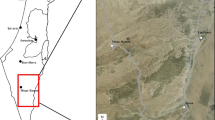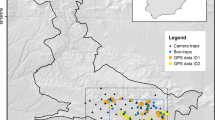Abstract
Most studies using photographic capture-recapture methodology estimate parameters of interest with ecological and sampling uncertainties. However, the effect of sampling effort on assumption violation and estimate precision has seldom been described using empirical data in studies estimating population size of tigers (Panthera tigris tigris). In this study, we evaluate the influence of trap effort (trap area, mean cell area and trap density) on the assumption of geographic closure and their relationship with estimated capture probability. We do this by subsampling capture histories obtained for tigers from 30 trapping stations within the Chilla range of Rajaji National Park, India. We assessed the importance of trapping effort on geographic closure by estimating fidelity (\( \overset{\lower0.5em\hbox{$\smash{\scriptscriptstyle\frown}$}}{F} \)) and immigration (\( \overset{\lower0.5em\hbox{$\smash{\scriptscriptstyle\frown}$}}{f} \)) under the Pradel model. Estimate precision (CV% [\( \hat{N} \)]) was evaluated based on estimates of capture probability (\( \hat{p} \)). Results of the Pradel analysis suggested that larger trap area (TA) ensured geographic closure, while high trap densities (TD) exhibited sex-specific heterogeneity in recapture probabilities p. Simulation results suggested a significant positive correlation between estimates of (\( \hat{p} \)) and TD. With increase in estimated capture probability, estimate precision (CV% [\( \hat{N} \)]) also improved sharply. Comparison of prior studies towards optimizing sampling strategies is often compromised due to the difference in scale and methods of sampling. Therefore, we urge that subsampling within a dataset as illustrated in our study may prove to be an advantageous step towards standardizing photographic capture-recapture sampling methodology for management objectives.




Similar content being viewed by others
References
Boulanger J, McLellan BN (2001) Closure violation bias in DNA based mark-recapture population estimates of grizzly bears. Can J Zool 79:642–651
Boulanger J, White GC, McLellan BN, Woods JG, Proctor MF, Himmer S (2002) A meta-analysis of grizzly bear DNA mark–recapture projects in British Columbia. Ursus 13:137–152
Brassel KE, Reif D (1979) A procedure to generate Thiessen polygons. Geogr Anal 325:31–36
Burnham KP, Anderson DR (1998) Model selection and inference: a practical information-theoretic approach. Springer, New York
Chauhan DS, Harihar A, Goyal SP, Qureshi Q, Lal PR, Mathur VB (2005) Estimating tiger population using camera traps in Ranthambore National Park. Wildlife Institute of India, Dehradun
Chauhan DS, Singh R, Mishra S, Dadda T, Goyal SP (2006) Estimation of tiger population in an intensive study area of Pakke Tiger Reserve, Arunachal Pradesh. Wildlife Institute of India, Dehradun
Cormack RM (1964) Estimates of survival from the sightings of marked animals. Biometrika 51:429–438
Efford M (2004) Density estimation in live-trapping studies. Oikos 106:598–610. doi:10.1111/j.0030-1299.2004.13043.x
Gittleman JL, Harvey PH (1982) Carnivore home range size, metabolic needs and ecology. Behav Ecol Sociobiol 10:57–63. doi:10.1007/BF00296396
Harihar A, Pandav B, Goyal SP (2008) Responses of tiger (Panthera tigris) and their prey to removal of anthropogenic influences in Rajaji National Park, India. Eur J Wildl Res. doi:10.1007/s10344-008-0219-2
Johnsingh AJT, Ramesh K, Qureshi Q, David A, Goyal SP, Rawat GS, Rajapandian K, Prasad S (2004) Conservation status of tiger and associated species in the Terai Arc Landscape. Wildlife Institute of India, Dehradun
Johnson A, Vongkhamheng C, Hedemark M, Saithongdam T (2006) Effects of human-carnivore conflict on tiger (Panthera tigris) and prey populations in Lao PDR. Anim Conserv 9:421–430. doi:10.1111/j.1469-1795.2006.00049.x
Jolly GM (1965) Explict estimates from capture-recapture data with both death and immigration: stochastic model. Biometrika 52:225–247
Karanth KU (1995) Estimating tiger Panthera tigris populations from camera-trapping data using capture-recapture models. Biol Conserv 71:333–338. doi:10.1016/0006-3207(94)00057-W
Karanth KU, Kumar NS (2003) Distribution and dynamics of tiger and prey populations in Maharashtra, India. Centre for Wildlife Studies, Bangalore
Karanth KU, Nichols JD (1998) Estimation of tiger densities using photographic captures and recaptures. Ecology 79:2852–2862
Karanth KU, Nichols JD (2000) Ecological status and conservation of tigers in India. Centre for Wildlife Studies, Bangalore
Karanth KU, Nichols JD (2002) Monitoring tigers and their prey: a manual for researchers, managers and conservationists in tropical Asia. Centre for Wildlife Studies, Bangalore
Karanth KU, Stith BM (1999) Prey depletion as a critical determinant of tiger densities. In: Seidensticker J, Christie S, Jackson P (eds) Riding the tiger: tiger conservation in human-dominated landscapes. Cambridge University Press, Cambridge, pp 100–113
Karanth KU, Sunquist ME (2000) Behavioural correlates of predation by tiger Panthera tigris, leopard Panthera pardus and dhole Cuon alpinus in Nagarahole, India. J Zool (Lond) 250:255–265. doi:10.1111/j.1469-7998.2000.tb01076.x
Karanth KU, Chundawat RS, Nichols JD, Kumar NS (2004) Estimation of tiger densities in the tropical dry forests of Panna, Central India, using photographic capture-recapture sampling. Anim Conserv 7:285–290. doi:10.1017/S1367943004001477
Karanth KU, Nichols JD, Kumar NS, Hines JE (2006) Assessing tiger population dynamics using photographic capture-recapture sampling. Ecology 87:2925–2937. doi:10.1890/0012-9658(2006)87[2925:ATPDUP]2.0.CO;2
Kawanishi K, Sunquist ME (2004) Conservation status of tigers in a primary rainforest of Peninsular Malaysia. Biol Conserv 120:329–344. doi:10.1016/j.biocon.2004.03.005
Kostyrya AV, Belozor AA (2002) Report on a camera trapping survey of tigers in Ussuriski Zapovednik and adjacent territory for winter and summer 2002. Vladivostok (in Russian)
Linkie M, Haidirb IA, Nugrohoc A, Dinatac Y (2008) Conserving tigers Panthera tigris in selectively logged Sumatran forests. Biol Conserv 141:2410–2415. doi:10.1016/j.biocon.2008.07.002
Lynam AJ, Laidlaw R, Shaharuddin W, Noordin W, Elagupillay S, Bennett EL (2007) Assessing the conservation status of the tiger Panthera tigris at priority sites in Peninsular Malaysia. Oryx 41:454–462. doi:10.1017/S0030605307001019
Lynam AJ, Rabinowitz A, Myint T, Maung M, Latt KW, Po SHT (2008) Estimating abundance with sparse data: tigers in northern Myanmar. Popul Ecol. doi:10.1007/s10144-008-0093-5
McDougal C (1977) The face of the tiger. Rivington Books, London
Miquelle DG, Smirnov EN, Merrill TW, Myslenkov AE, Quigley HB, Hornocker MG, Schleyer B (1999) Hierarchical spatial analysis of Amur tiger relationships to habitat and prey. In: Seidensticker J, Christie S, Jackson P (eds) Riding the tiger: tiger conservation in human-dominated landscapes. Cambridge University Press, Cambridge, pp 71–99
O’Brien TG, Kinnaird MF, Wibisono HT (2003) Crouching tigers, hidden prey: Sumatran tiger and prey populations in a tropical forest landscape. Anim Conserv 6:131–139. doi:10.1017/S1367943003003172
Otis DL, Burnham KP, White GC, Anderson DR (1978) Statistical inference from capture data of closed populations. Wildl Monogr 62:1–135
Pledger S (2000) Unified maximum likelihood estimates for closed capture-recapture models for mixtures. Biometrics 56:434–442. doi:10.1111/j.0006-341X.2000.00434.x
Pollock KH, Nichols JD, Brownie C, Hines JE (1990) Statistical inference for capture-recapture experiments. Wildl Monogr 107:1–97
Pradel R (1996) Utilization of mark—recapture for the study of recruitment and population growth rate. Biometrics 52:703–709. doi:10.2307/2532908
Schaller GB (1967) The deer and the tiger. University of Chicago Press, Chicago
Seber GAF (1965) A note on the multiple recapture census. Biometrika 52:249–259
Sharma R (2005) Evaluating tiger (Panthera tigris) population estimation approaches in a high density area in Kanha Tiger Reserve. M.Sc.Thesis/Dissertation, Saurashtra University, Rajkot
Simcharoen S, Pattanavibool A, Karanth KU, Nichols JD, Kumar NS (2007) How many tigers Panthera tigris are there in Huai Kha Khaeng Wildlife Sanctuary, Thailand? An estimate using photographic capture–recapture sampling. Oryx 41:447–453. doi:10.1017/S0030605307414107
Smith JLD (1993) The role of dispersal in structuring the Chitwan tiger population. Behaviour 124:165–195. doi:10.1163/156853993X00560
Smith JLD, McDougal C, Sunquist ME (1987) Female land tenure system in tigers. In: Tilson RL, Seal US (eds) Tigers of the world. Noyes Publications, New Jersey, pp 97–109
Sunquist ME (1981) Social organization of tigers Panthera tigris in Royal Chitwan National Park, Nepal. Smithson Contrib Zool 336:1–98
Wegge P, Pokheral C, Jnawali SR (2004) Effects of trapping effort and trap shyness on estimates of tiger abundance from camera trap studies. Anim Conserv 7:251–256. doi:10.1017/S1367943004001441
White GC, Burnham KP (1999) Program MARK: survival estimation from populations of marked animals. Bird Study 46:120–138
White GC, Anderson DR, Burnham KP, Otis DL (1982) Capture recapture and removal methods for sampling closed populations. LA-8787-NERP, Los Alamos National Laboratory, Los Alamos
Acknowledgments
This study was funded by Save the Tiger Fund (Grant 2005-0013-027) and supported by the Wildlife Institute of India (WII). We thank the Director and Dean (WII), the Uttarakhand Forest Department and the ongoing Rajaji monitoring project (WII) for providing permissions and additional logistic support. The comments of two anonymous reviewers were very useful in improving the contents of the manuscript. Imam, Mumtaj and Rakesh are thanked for their assistance in fieldwork. Our sincere thanks to John Boulanger and J. Seidensticker for suggestions on earlier versions of the manuscript. A. H. would also like to thank Mousumi Ghosh for her help during data analysis and preparation of the manuscript.
Author information
Authors and Affiliations
Corresponding author
Rights and permissions
About this article
Cite this article
Harihar, A., Pandav, B. & Goyal, S.P. Subsampling photographic capture-recapture data of tigers (Panthera tigris) to minimize closure violation and improve estimate precision: a case study. Popul Ecol 51, 471–479 (2009). https://doi.org/10.1007/s10144-009-0138-4
Received:
Accepted:
Published:
Issue Date:
DOI: https://doi.org/10.1007/s10144-009-0138-4




